2025 Perp DEX Status: Strong Development Momentum, Transaction Volume Soaring
Original author: Launchy
ต้นฉบับแปล: TechFlow
Perpetual DEXs have rapidly evolved from being experimental DeFi tools to becoming a major player in the การเข้ารหัสลับ derivatives market. In 2024, this sector has seen explosive growth, with total trading volume across Perp DEXs reaching $1.5 trillion, more than doubling from $647.6 billion in 2023. Trading volume in December alone reached $344.75 billion, setting a new monthly high.
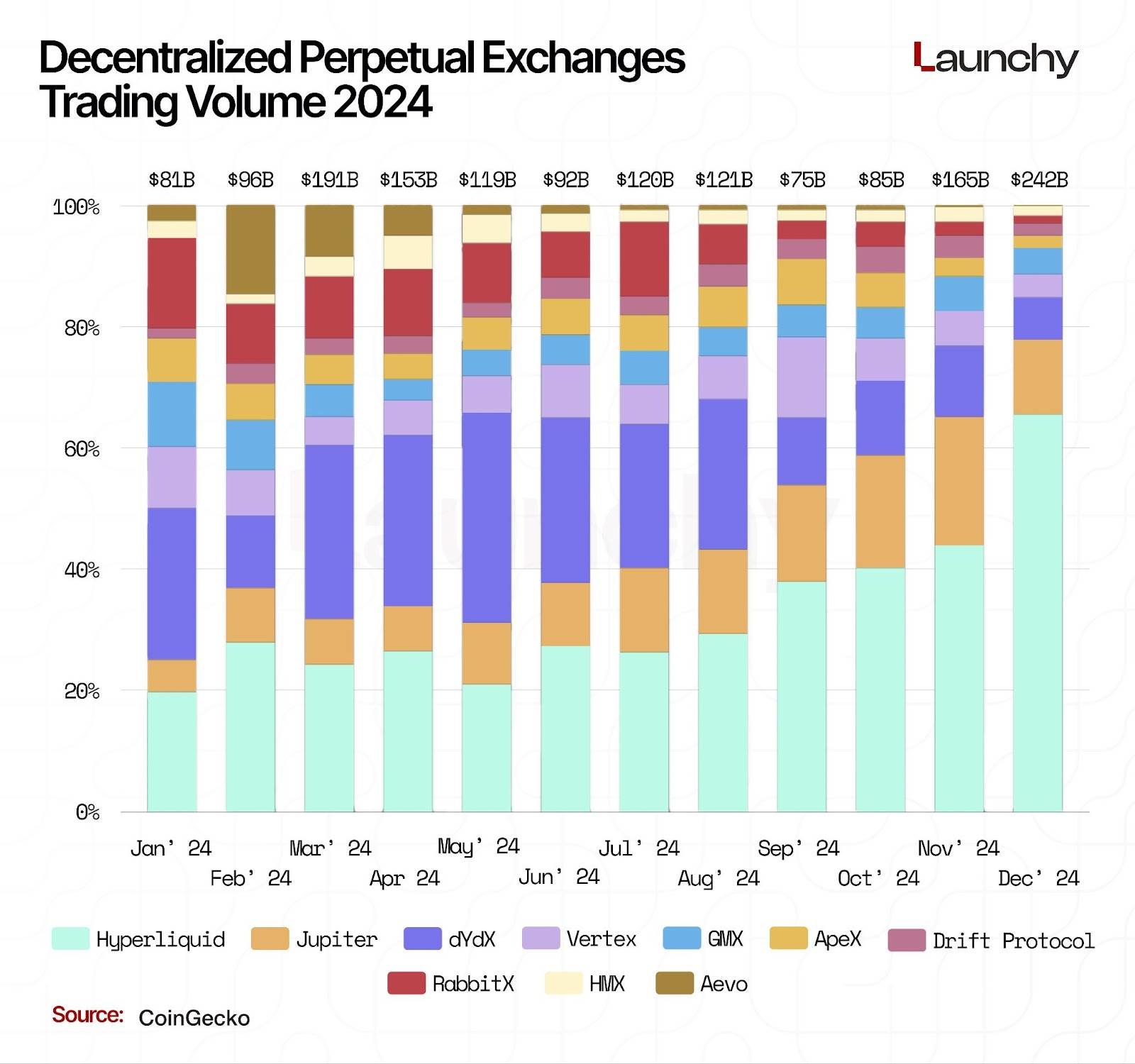
Data source: CoinGecko
This surge is mainly due to platforms like Hyperliquid, whose annual trading volume soared from $21 billion in 2023 to $570 billion in 2024, a 25.3-fold increase. Drift and Jupiter also achieved significant breakthroughs, with annual trading volumes increasing by 628% and 5176% year-on-year, respectively.
With the emergence of innovations like native order books, fast-finality chains, zk-enabled features, and app-specific ecosystems, 2025 lays the foundation for the next phase of perpetual DEXs: mainstream adoption.
This report explores the data behind this evolution, the platforms leading the way, and the technology and market trends that will shape the future of Perp DEXs.
จุดสำคัญ
-
Hyperliquid dominates the DeFi perpetual trading market:
Hyperliquid currently accounts for 80% of the decentralized perpetual DEX market, with a monthly trading volume of $165 billion. Its retail-first token model has helped it achieve strong momentum without venture capital support.
-
Perp DEX transaction volume surges in 2024:
The market grows from $647.6 billion in 2023 to over $1.5 trillion in 2024. Trading volume in December alone reached $344.75 billion, showing a rapid acceleration in user activity.
-
Top platforms are consolidating market share:
Currently, a handful of platforms dominate the perpetual DEX activity. Hyperliquid, Jupiter, ApeX, RabbitX, and MYX lead in terms of trading volume and user base due to their superior execution and network effects.
-
Solana and Arbitrum become the main support forces:
These blockchains power the fastest growing DEXs with low latency and scalable infrastructure. Jupiter is based on Solana, while Hyperliquid is based on Arbitrum, fully embodying chain-specific advantages.
-
Centralized exchanges (CEX) still dominate, but the gap is narrowing:
In May 2025, Binance鈥檚 trading volume reached $1.7 trillion, but Hyperliquid鈥檚 trading volume accounted for about 9% of it. As more and more traders prefer self-custody and transparency, DEXs are catching up quickly.
Perpetual DEX ตลาด Overview
The Perp DEX market has reached all-time highs in both usage and innovation as we enter 2025. Trading volume has increased by more than 138% year-over-year, with total trading volume across top DEXs exceeding $1.5 trillion.
In the fourth quarter of 2024, Hyperliquid accounted for more than 55% of the trading volume, especially after a large-scale airdrop activity in December, its market share surged to 66%. At the same time, the market share of dYdX, once the market leader, fell sharply from 73% in January 2023 to 7% at the end of 2024. Jupiter based on Solana has quickly risen to become the second largest perpetual DEX, and Solana itself contributes 15% of Perp DEXs trading volume.
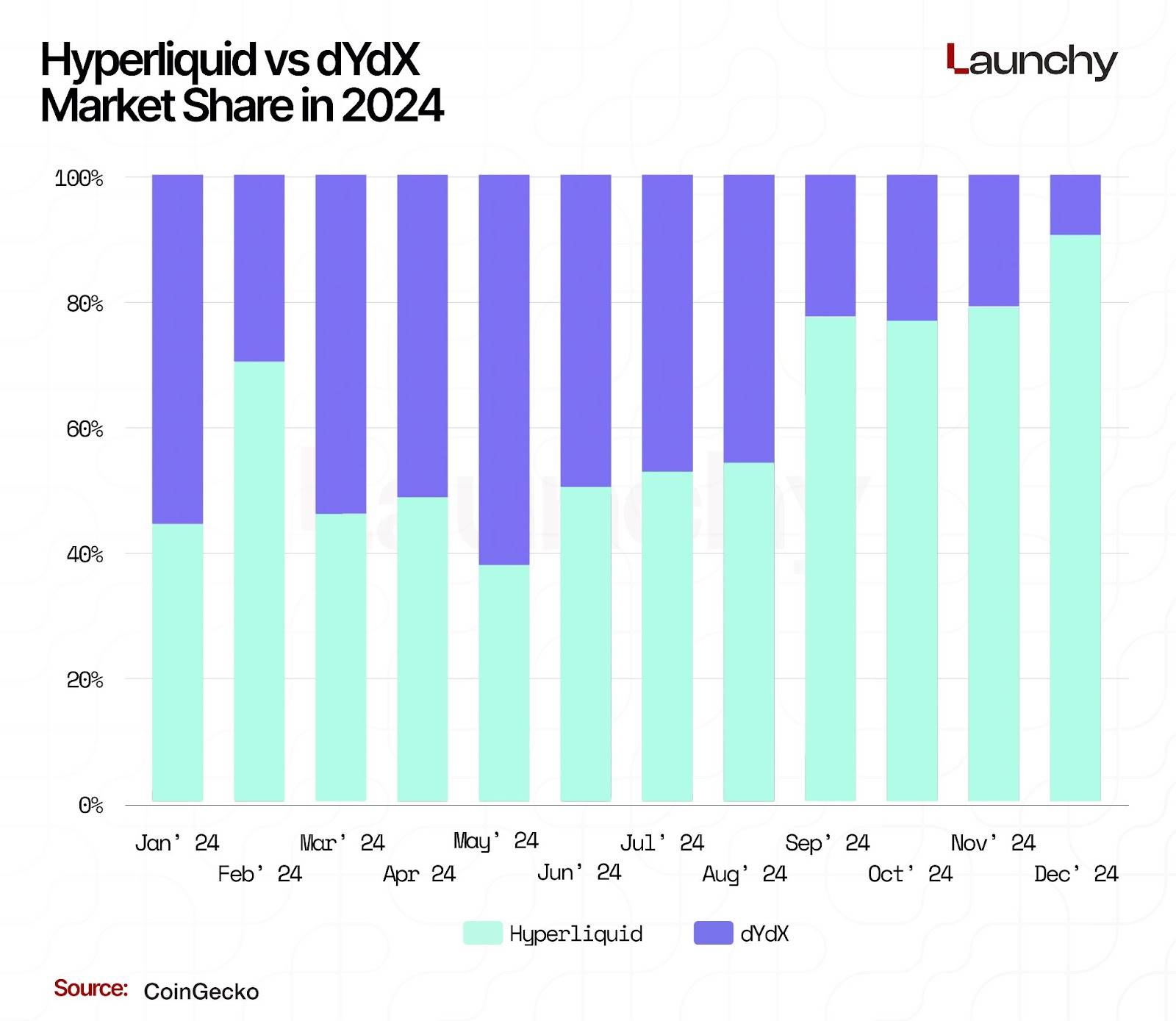
As of November 2024, the total open interest of the centralized perpetual market has exceeded $100 billion, but decentralized platforms are rapidly closing the gap. Perpetual DEXs are currently competitive in terms of liquidity, execution speed, and composability, and 2025 is expected to be a key year for the transition from centralized to decentralized derivatives trading.
Current landscape

As of mid-2025, the perpetual DEX market landscape is concentrating on a few dominant platforms, with Hyperliquid leading the pack. Currently, its 24-hour trading volume is $11.25 billion, and its cumulative trading volume is as high as $1.58 trillion, far exceeding its closest competitor. This growth is due to its strong infrastructure, broad support for 130 assets, and its Arbitrum-based platform advantages.
Following closely behind is Jupiter, the leading perpetual DEX based on Solana, with a daily trading volume of $570.85 million and a cumulative trading volume of $312.13 billion, successfully carving out its own market with Solanas low-latency environment. In addition, other platforms worth noting include Vertex (cumulative trading volume of $217.91 billion), ApeX (197.99 billion), and RabbitX (166.95 billion). Many of these platforms support multi-chain deployment, expanding users access and liquidity depth.
DEXs have also become more aggressive in terms of leverage competition. Gains Trade offers up to 500x leverage, covering 230 assets; ApolloX offers 1001x leverage, while Equation offers 150x leverage, attracting the attention of high-risk traders. At the same time, platforms such as RabbitX and Drift highlight their focus on cost efficiency for active users by offering 0.00% maker and taker fees.
Solana and Arbitrum remain the most common underlying chains, and multiple platforms such as SynFutures, GMX, and Drift have leveraged the scalability of Rollup or application-specific L1 chains. Although dYdXs market dominance has declined, its cumulative trading volume still reached $1.49 trillion and it runs on five major chains.
With the deepening of liquidity, the acceleration of multi-chain expansion, and the intensification of competition around user incentives, the perpetual DEX field is evolving rapidly. The focus of market competition is no longer who goes online first, but who can scale quickly, reliably execute and provide the best trading experience.
Top 10 Perpetual DEXs by Trading Volume
As of mid-2025, the Perp DEX space is dominated by a handful of dominant platforms, with trading activity increasingly concentrated in the top 10 protocols. The following rankings are based on current 24-hour and cumulative trading volumes, demonstrating the scale and competitiveness of each platform.
-
Hyperliquid

30-day trading volume: $254.81 billion
Cumulative trading volume: $1.58 trillion
Supported chains: 1 (Arbitrum)
Hyperliquid continues to take the lead in the perpetual DEX market with its high-performance Arbitrum native infrastructure, support for 130 trading pairs, and extremely active user base. Its cumulative trading volume has exceeded 1.5 trillion US dollars, and its daily trading volume even exceeds many centralized exchanges (CEX).
-
Aster
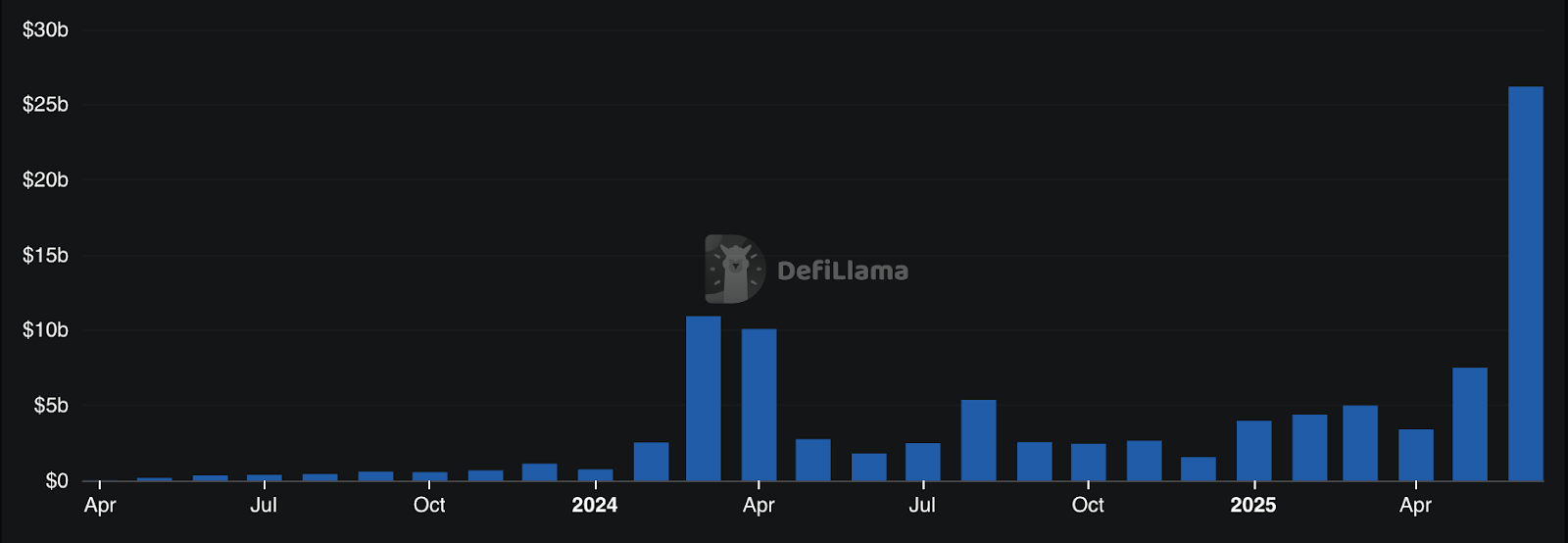
30-day trading volume: $28.16 billion
Cumulative transaction volume: unknown
Supported chains: 4 (BNB Chain, Ethereum, Solana, and Arbitrum)
Aster is the biggest newcomer on the list, vaulting into second place with strong multi-chain support. Its rapid rise shows that traders are growing interested in alternatives that offer wider access.
-
Jupiter
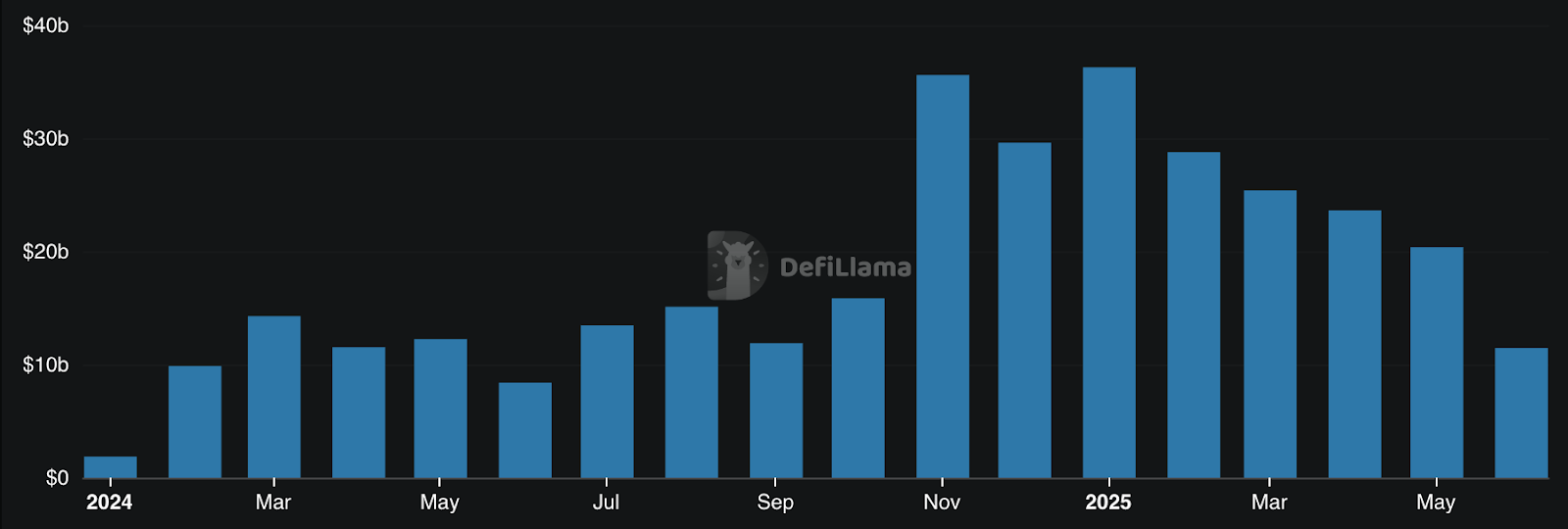
30-day trading volume: $19.61 billion
Cumulative trading volume: $312.13 billion
Supported chains: 1 (Solana)
Jupiter remains a major force on Solana, focusing on a small number of trading pairs and providing deep liquidity. Although its 30-day trading volume is down compared to other platforms, its long-term growth momentum remains strong.
-
ApeX Protocol
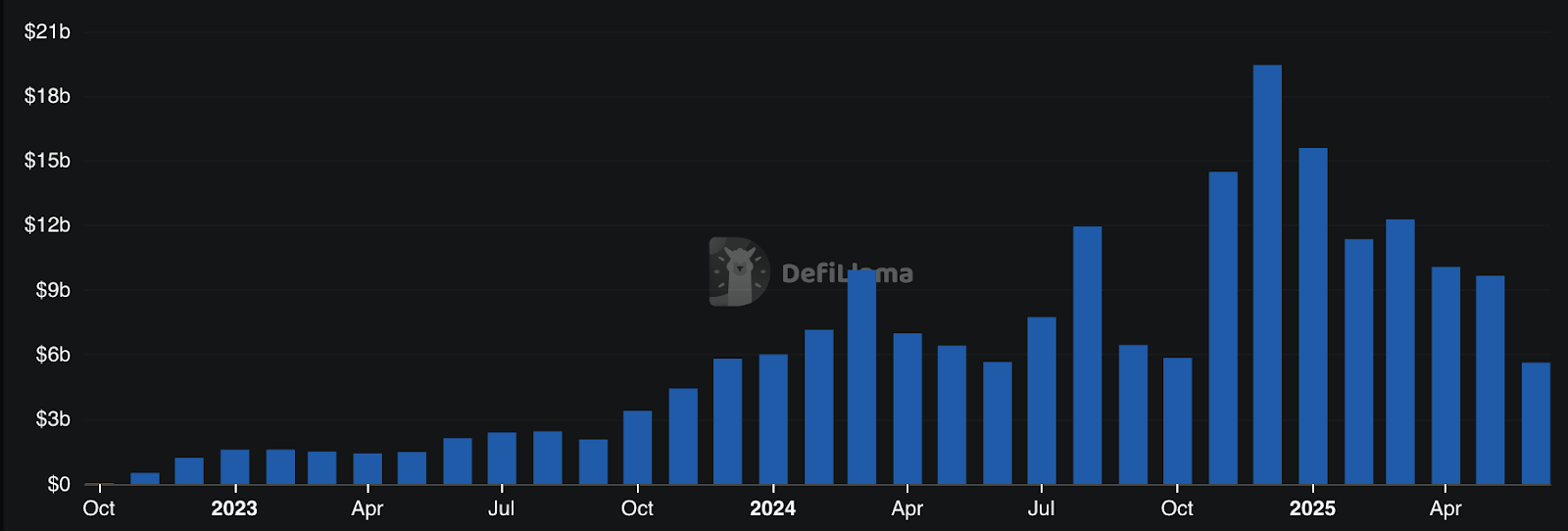
30-day trading volume: $8.98 billion
Cumulative trading volume: $197.99 billion
Supported chains: 1 (Ethereum-compatible Layer 2 based on StarkWare)
Despite its focus on a single chain, ApeX still sees impressive trading volumes thanks to strong liquidity, support for 20 tokens, and a simplified user experience (UX).
-
RabbitX Fusion
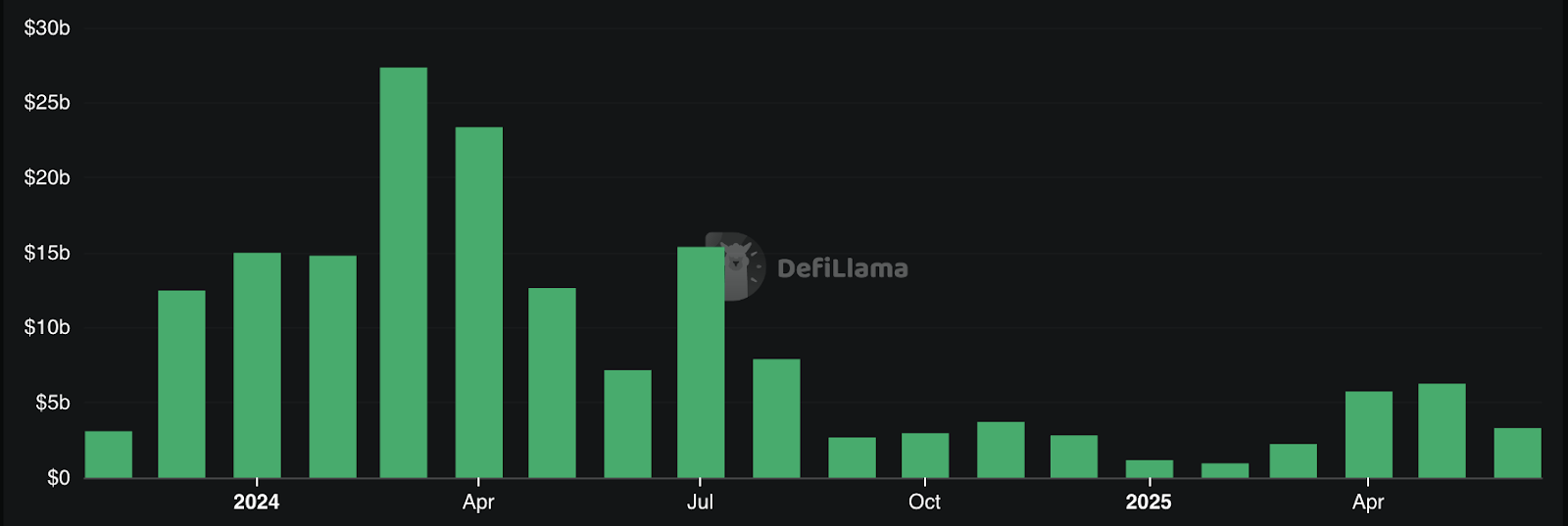
30-day trading volume: $5.84 billion
Cumulative trading volume: $166.95 billion
Supported chains: 1 (StarkNet)
RabbitX remains competitive with its zero-fee structure and institutional-oriented infrastructure, and is particularly popular among cross-exchange arbitrage traders.
-
edgeX

edgeX Perps Data / DefiLlama
30-day trading volume: $7.52 billion
Cumulative transaction volume: unknown
Supported chains: 1 (Ethereum-compatible Layer 2 based on StarkWare)
As a dark horse, edgeX has demonstrated strong transaction data in its early stages thanks to its simplified user experience and single-chain deployment.
-
การเงิน MYX

MYX Finance Perps Data/DefiLlama
30-day trading volume: $7.5 billion
Cumulative transaction volume: unknown
Supported chains: 4 (Arbitrum, BNB Chain, Linea)
MYX spreads risk through multi-chain expansion and captures liquidity in different ecosystems. Its flexibility is particularly prominent during periods of market volatility.
-
จีเอ็มเอ็กซ์

GMX Perps Data / DefiLlama
30-day trading volume: $6.02 billion
Cumulative trading volume: $261.91 billion
Support chains: 3 (ARB, AVAX, etc.)
As a veteran player in the perpetual DEX, GMX still occupies a place in the fierce competition with its community trust and deep liquidity foundation.
-
ดีเอ็กซ์

dYdX Perps Data / DefiLlama
30-day trading volume: $5.42 billion
Cumulative trading volume: $1.49 trillion
Supported chains: 2 (ETH, Cosmos)
dYdX remains one of the most mature platforms. Its move to a dedicated chain (V4) based on Cosmos has reduced latency, but its relative share of volume has declined.
-
Paradex

Paradex Perps Data / DefiLlama
30-day trading volume: $3.35 billion
Cumulative transaction volume: unknown
Supported chains: 1 (Paradex Chain)
Paradex is a newcomer to the top 10 and is growing rapidly in usage. Its single-chain setup simplifies execution while centralizing liquidity.
Full list of Perp DEX
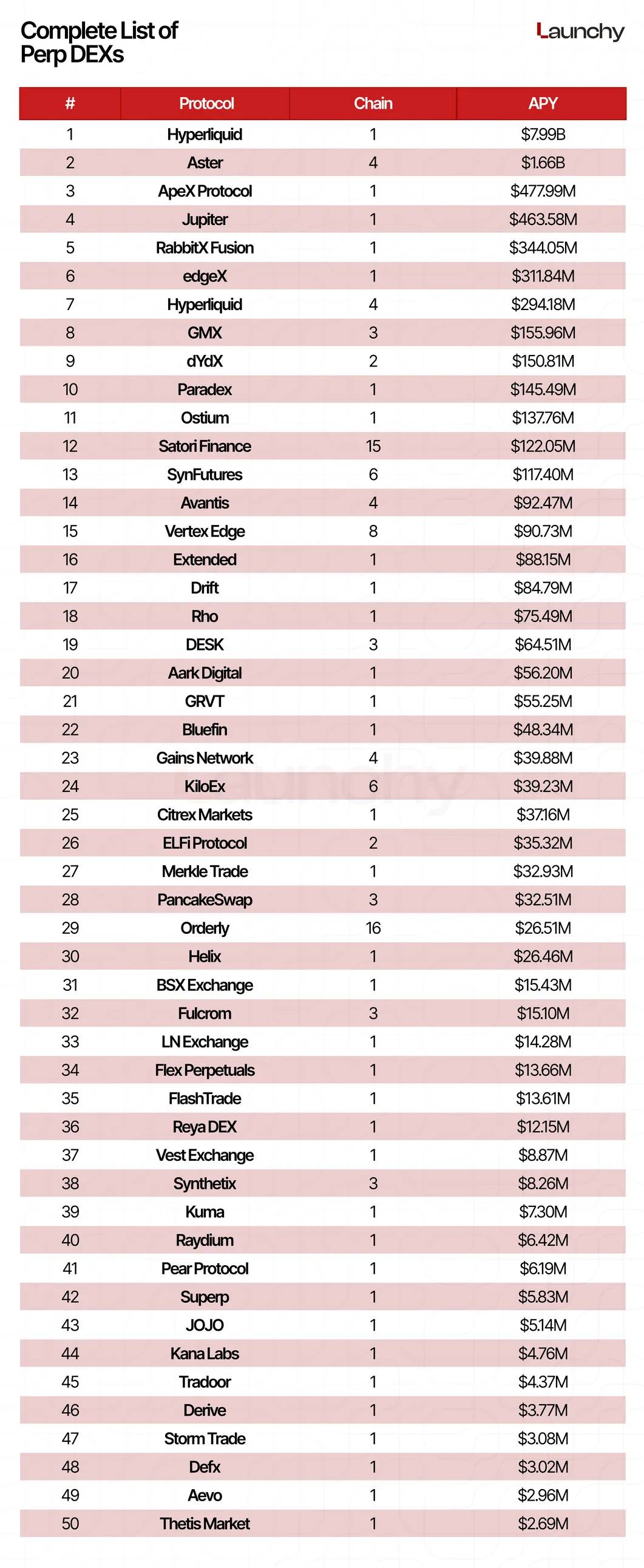
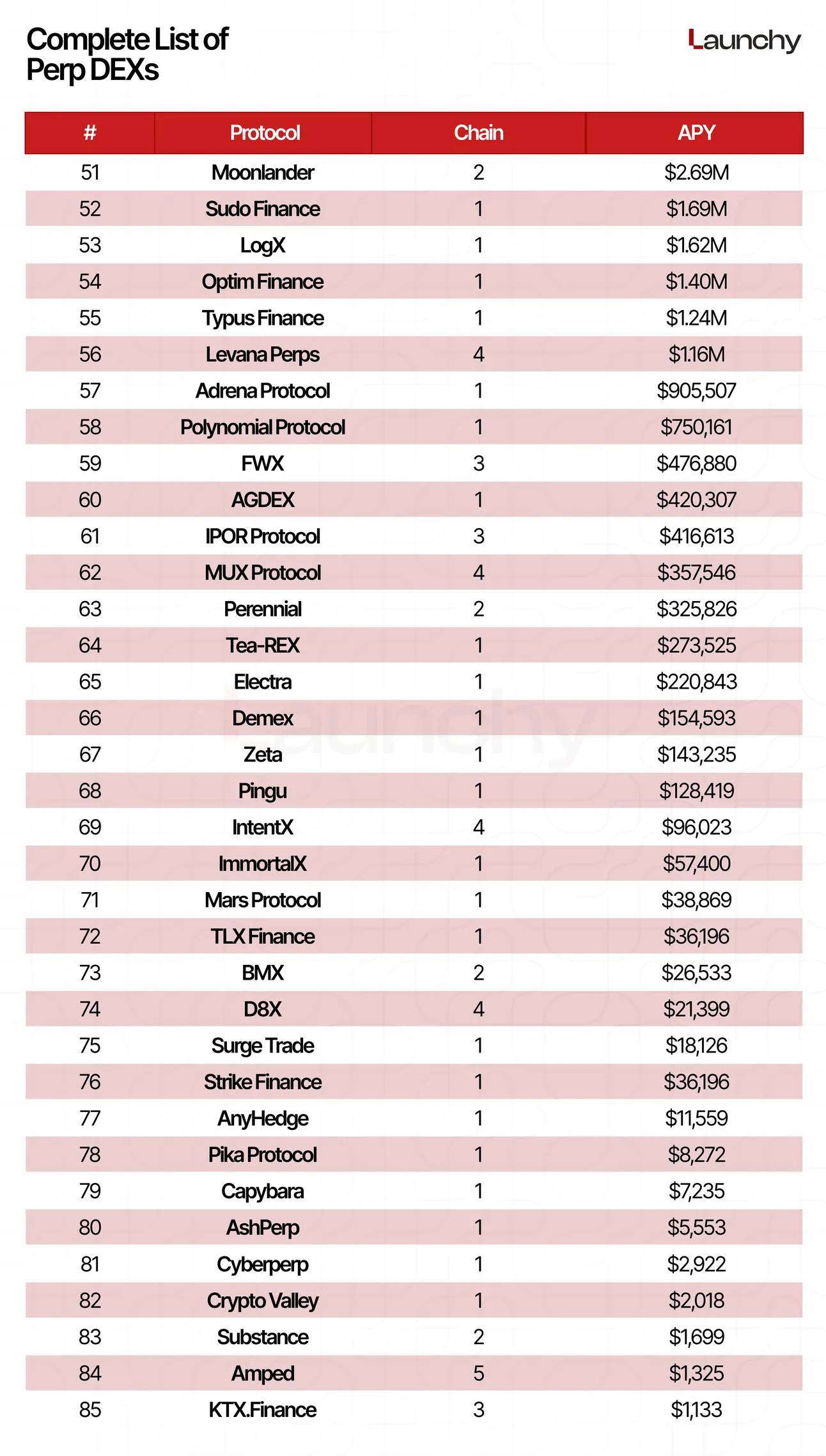
CEX and DEX market share competition
Centralized exchanges (CEX) such as Binance, OKX, and Bybit have long dominated the perpetual contract market, with monthly trading volumes stabilizing in the trillions of dollars. However, decentralized perpetual exchanges (DEX) are gradually emerging, and one protocol is leading the way: Hyperliquid.
As of May 2025, Hyperliquid holds 80% of the decentralized perpetual market. This is a significant increase from 30% in November 2024. In just six months, the protocol has more than doubled its market share, demonstrating growing demand for platforms that support self-custody, permissionless access, and minimal counterparty risk.

Hyperliquid is not your average DEX. Unlike many projects that were launched with VC funding, it was developed autonomously without venture capital support. As a result, all token holders (including institutions) must purchase HYPE through the open market. This model avoids common issues associated with token unlocking schedules and facilitates a more organic, retail-led growth path.
Despite Hyperliquid鈥檚 dominance among DEXs, it still has a smaller share of the entire perpetual market. In May 2025, the protocol had a trading volume of $165 billion, while Binance鈥檚 volume was $1.7 trillion. Hyperliquid is only about 9% of Binance鈥檚 size, but this proportion is steadily increasing.
Overall, Binance still dominates the centralized market with an absolute advantage, but the gap is narrowing. According to the latest data, Hyperliquids trading volume has reached 12% of Binance, gradually increasing from almost zero at the beginning of 2023.
As regulatory pressure on centralized exchanges increases, and demand for more control and transparency among traders rises, DEXs like Hyperliquid are becoming viable alternatives. If current trends continue, the lines between centralized and decentralized perpetual markets will blur further in the coming months.
สรุป
Perpetual DEX has matured. From the initial niche DeFi field, these protocols now have the realistic possibility of challenging centralized giants. Hyperliquids model and performance prove that as long as the user experience of decentralized platforms is competitive enough, users are willing to turn to this new option.
While centralized platforms face regulatory uncertainty, decentralized technologies are advancing rapidly and the momentum in the industry is shifting.
The competition in 2025 will not only be about innovation, but also about scale, reliability, and user experience. The next generation of crypto traders may never need to touch a centralized exchange again.
Disclaimer: This article and its associated content are for educational purposes only and should not be considered or offered as financial, legal, investment or any other form of advice.
This article is sourced from the internet: 2025 Perp DEX Status: Strong Development Momentum, Transaction Volume Soaring
Preface In the early narrative of the Web3 industry, GameFi is second only to DeFi, and is the second independent narrative that has reached industry consensus and established logic. In the early days, the public game chain was not an independent concept, and the game distribution platform dominated the development of chain games. Before 2020, most Web3 games used Ethereums smart contracts to realize the purchase and sale of NFT equipment. Play-to-Earn is the first demand of most players, so the game experience is often put second. In Web2 games, game performance will drive the upgrading of personal console performance. In 2017, PlayerUnknowns Battlegrounds led gamers to upgrade their console graphics cards to RTX 1050 or above, and in 2021, Cyberpunk 2077 allowed players to upgrade their game graphics cards…







